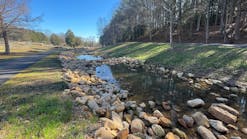Coyote Creek Feasibility Study Receives Army Corps Assistance
Source Santa Clara Valley Water District
In an action that will be among the first in the nation, the U.S. Army Corps of Engineers agreed to partner with Santa Clara Valley Water District to develop a feasibility study for reducing flood risks on Coyote Creek in Santa Clara County. This partnership is an important step toward securing funding from the U.S. government and state of California for a flood protection project for this creek.
Coyote Creek flooded thousands of residents in February 2017, damaging homes, property and personal belongings. Subsequently, the water district sought federal assistance to reduce future flooding of the creek.
In a July 14 letter to the water district, Lieutenant Colonel Travis J. Rayfield of the San Francisco District of the Army Corps, accepted the district’s request to enter into a partnership with the water district to develop a feasibility study for Coyote Creek. Under the formal agreement, which will now be drafted, the district will pay the Army Corps for the provision of technical assistance in the development of a feasibility study.
“This commitment from the Army Corps is a big win for those who live in areas prone to flooding on Coyote Creek,” said the water district’s board chair, John L. Varela. “We are grateful to Representatives Lofgren and Khanna for advocating for this action. We are running on all cylinders to push for long-needed flood risk reduction measures for Coyote Creek.”
“A feasibility study is an important step towards securing federal support for infrastructure improvements,” said Congresswoman Lofgren, who led a letter of support for the partnership this May. “We need to prevent the sort of flooding San Jose suffered earlier this year.”
“This feasibility study is a necessary action to better understand the flood risks facing the communities on and around Coyote Creek,” said Congressman Khanna. “It is my hope that the findings from it can prevent another disaster like the President’s Day flood.”
A Civil Works Feasibility Study is the initial step in the U.S. Army Corps of Engineers process for addressing flood risk reduction. The study establishes the federal interest, engineering feasibility, economic justification and environmental acceptability of a water resource project recommended for Congressional authorization and construction.
Section 1126 of the Water Resources Development Act of 2016 provides the water district with the ability and flexibility to advance an Army Corps feasibility process without federal funding or approvals. This commitment marks the first such application of Section 1126 in the nation.
Close coordination with the Army Corps by the water district for important study elements such as technical assistance will ensure that the feasibility report produced by the water district will meet the rigorous requirements of the Army Corps planning process. The planning process concludes with the acceptance of the report by the Chief of Engineers Report (also known as the Chief’s Report) making it eligible for congressional authorization.
Prior to the enactment of this Section 1126, which passed as part of the Water Infrastructure Improvements for the Nation (WIIN) Act in December, non-federal interests would have to wait for the federal government to fund and carry out a feasibility study. By paying for the Army Corps’ technical assistance, the feasibility study can commence as soon as an agreement is signed between the two agencies.
While the water district will pay the Army Corps for the services provided, the agreement is a first step in establishing a federal interest in an eventual project. A federal interest, which indicates that a project’s benefits exceed the costs, must be established before the federal and state governments can contribute funding for a flood protection project. Given the high cost of a flood protection project for Coyote Creek, federal and state support is essential to provide adequate protection to the communities at risk of future flooding.
Prior to this year’s flooding, flooding occurred in similar areas along Coyote Creek during storms that occurred 20 years ago, in 1997. At that time, the water district sought assistance from the Army Corps to create flood control measures, but was turned down, as it was determined that there was not a federal interest at that time.
Source: Santa Clara Valley Water District






